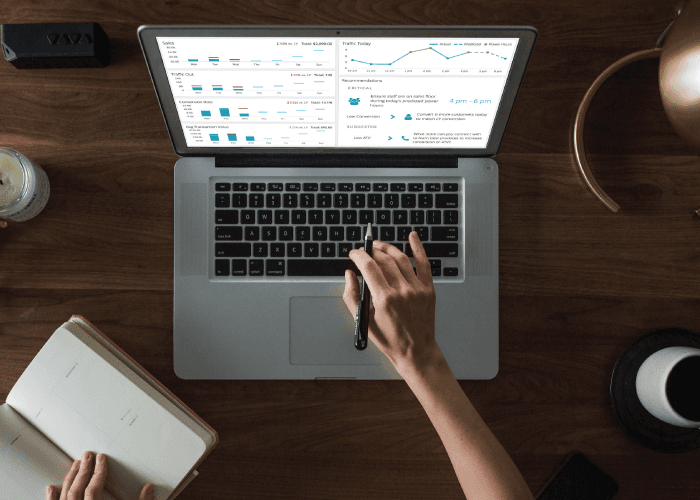How Store Analytics Prove Retail Media Network ROI In 2025

On this page
Forbes reports that retail media has emerged as one of the fastest-growing sectors in advertising, projected to surpass $231 billion by 2030, in part because two-thirds of online product searches start on retailer sites and brands can leverage retail media networks (RMNs) to connect with consumers directly at that point. The physical store is now a sophisticated, measurable media platform. As brands demand the same accountability from in-store advertising that they expect from digital campaigns, retailers who can prove performance will capture a disproportionate share of the projected multi-billion-dollar retail media market by 2027.
The transformation of stores into media networks isn't just about installing digital screens. It's about creating intelligent, responsive advertising ecosystems that adapt to actual shopper behavior. This is where advanced analytics platforms become the critical infrastructure that turns static retail spaces into dynamic media opportunities.
READ MORE: Why Retail Media Networks Are The Future For Stores
The Billion Dollar Opportunity Hiding In Plain Sight
For decades, in-store advertising operated on faith. Brands paid for endcap displays, shelf talkers, and floor graphics based on foot traffic estimates and general assumptions about visibility. CPG companies spent billions on these placements with limited ability to measure actual engagement or conversion impact. That era is ending.
Today's retail media networks are expanding beyond search results and display ads into the physical environment where majority of retail sales still occur. Major retailers are investing heavily in digital signage, interactive displays, and even augmented reality experiences. But without sophisticated measurement capabilities, these investments risk becoming expensive decorations rather than revenue-generating assets.
The retailers winning this race understand a fundamental truth: the value of in-store media isn't determined by the number of screens installed, but by the ability to prove that advertising drives measurable business outcomes. This requires granular analytics that connect media exposure to shopping behavior in real-time.
From Guesswork To Guaranteed Performance
RetailNext's analytics platform transforms how retailers validate and optimize in-store media performance through three critical capabilities that were previously impossible at scale.
First, our traffic counting technology provides precise measurement of shopper exposure. Unlike traditional door counters that simply track entries, we map actual shopper paths through stores, identifying exactly how many people pass specific media placements and for how long. This creates the foundation for calculating true impression metrics comparable to digital advertising standards.
Consider how a grocery chain might use our platform to measure digital endcap displays. Traditional door counters might show 50,000 weekly store visitors, but shopper journey analytics could reveal that only a fraction of those shoppers actually pass specific endcaps. For those who do enter the endcap zones, the platform can measure precise dwell time and engagement. This type of granular data enables retailers to price media based on verified impressions rather than store-wide traffic estimates, potentially increasing CPMs significantly while actually delivering better value to advertisers through guaranteed exposure metrics.
Second, heat mapping technology identifies optimal placement zones before media is installed. By analyzing historical traffic patterns, dwell time, and conversion data, retailers can predict which locations will generate the highest engagement. For instance, a fashion retailer might discover through heat map analysis that their highest-traffic areas near entrances actually have the lowest engagement rates due to shopper mission mindset. In this scenario, moving digital displays to specific zones where shoppers naturally pause could dramatically increase message recall and engagement.
Third, our platform enables real-time attribution by connecting media exposure to actual purchase behavior. When shoppers interact with promoted products after viewing in-store media, our analytics capture these conversion events, providing closed-loop measurement that rivals digital advertising platforms.
READ MORE: How Analytics Drove 40% Shopper Yield Growth For Boggi Milano
The Science Of Placement Optimization
The difference between random media placement and analytically-optimized positioning can mean millions in incremental revenue. Our platform reveals patterns invisible to conventional observation.
Shopper journey analytics expose the natural flow patterns that determine media effectiveness. Analysis typically reveals that shoppers follow predictable paths based on store layout, category adjacencies, and mission types. Media placed along these dominant paths can potentially generate significantly more impressions than locations that seem busy but actually serve as pass-through zones.
Dwell time analysis adds another optimization layer. Heat mapping data suggests that media performs best in locations where shoppers naturally decelerate: produce sections where they select items, service counters where they wait, and comparison zones where they evaluate options. For example, a consumer electronics retailer could dramatically increase media engagement by moving screens from high-traffic aisles to areas where analytics show shoppers spend extended time comparing products.
Time-based optimization represents the next evolution. Our platform shows that media effectiveness varies dramatically by hour, day, and season. Morning shoppers on weekdays exhibit different engagement patterns than weekend afternoon browsers. Smart retailers use these insights to implement dynamic pricing models, charging premium rates for high-engagement periods while offering value pricing during lower-impact windows.
Building Trust Through Transparency
The expansion of in-store media networks faces a critical challenge that goes beyond advertiser confidence: maintaining consumer trust in an era of heightened privacy awareness. With GDPR setting the global standard and CCPA establishing strict requirements in California, retailers must prove their media networks respect consumer privacy while delivering measurable results. Transparency isn't just good practice anymore; it's a legal requirement and business imperative.
Modern privacy legislation demands that retailers clearly communicate how they collect and use shopper data, even when that data is anonymized for analytics purposes. CCPA grants consumers the right to know what information businesses collect about them, while GDPR requires explicit consent for data processing. For retail media networks, this means building analytics infrastructure that provides powerful insights while maintaining complete compliance with privacy regulations. RetailNext's platform achieves this balance by focusing on aggregated, anonymized traffic patterns rather than individual shopper tracking, enabling sophisticated media measurement without compromising privacy.
The cost of non-compliance extends far beyond regulatory fines, which can reach 4% of global revenue under GDPR. The reputational damage from privacy violations can destroy decades of brand equity overnight. When a major retailer faces privacy scrutiny, consumer trust evaporates, foot traffic declines, and brand partners distance themselves. The indirect costs multiply: executive time consumed by crisis management, legal fees that dwarf initial fines, technology overhauls to achieve compliance, and lost opportunities as innovation stalls. Most damaging is the competitive disadvantage when privacy-conscious consumers and premium advertisers migrate to retailers who demonstrate transparent, ethical data practices.

This transparency requirement actually creates opportunity for forward-thinking retailers. Advertisers increasingly prefer partners who can guarantee their campaigns won't create privacy liabilities. RetailNext's platform provides detailed performance reports that prove media effectiveness while maintaining complete shopper anonymity, allowing retailers to offer transparency reports that satisfy both advertisers and regulators.
One approach gaining traction involves sharing aggregated performance metrics that demonstrate media impact without exposing individual behavior. Retailers can show heat maps indicating high-engagement zones, traffic flow patterns revealing optimal placement locations, and conversion lift metrics proving campaign effectiveness, all while maintaining complete GDPR and CCPA compliance. This level of transparency, backed by privacy-compliant analytics, commands premium rates from advertisers who value both performance and regulatory safety.
The Competitive Advantage Of Analytical Intelligence
As retail media networks proliferate, differentiation will come from measurement sophistication. Retailers with basic traffic counting will compete on price. Those with advanced analytics will compete on performance.
Our platform enables predictive optimization that goes beyond historical analysis. Ever-evolving algorithms identify patterns in shopper behavior, media engagement, and conversion rates to forecast future performance. Retailers can guarantee minimum impression levels, predict conversion rates for specific placements, and optimize media mix for maximum advertiser ROI.
The integration of real-time occupancy monitoring adds dynamic capability. Digital signage can adapt content based on current store conditions: promoting cold beverages when traffic peaks on hot days, highlighting quick meal solutions during evening rush periods, or featuring premium products when our analytics detect higher-income shopper profiles based on journey patterns.
This analytical intelligence creates a virtuous cycle. Better measurement attracts premium advertisers. Higher revenues justify technology investments. Improved capabilities enable more sophisticated campaigns. The retailers who build this cycle fastest will dominate the physical retail media landscape.
WATCH NOW: How Dave & Buster’s Pipes RetailNext Data Into Their AI
The transformation of stores into media networks is accelerating. Retailers who act now to implement comprehensive analytics will capture disproportionate value as advertising budgets shift from digital-only strategies to omnichannel approaches.
Success requires three strategic commitments.
Invest in analytics infrastructure that provides granular, real-time measurement of shopper behavior and media performance.
Build transparent reporting capabilities that give advertisers confidence in their investments.
Develop organizational capabilities to operate stores as media platforms, not just merchandise venues.
About the author:

Ashton Kirsten, Global Brand Manager, RetailNext
Ashton holds a Master's Degree in English and is passionate about physical retail's unbridled potential to excite, entertain, serve, and solve problems for today's shoppers.



